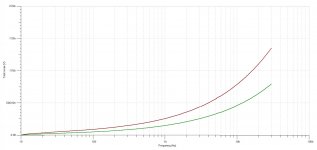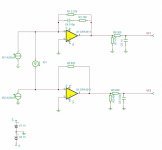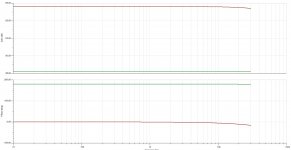On 9038pro In Sync I used 2xFs, it works, in Async - 100MHz, also works.I've tried DSD256(FS=11.2MHz) on ES9038Q2M(in slave mode), feeding es9038 with 2xFS, no success in async mode, but also no success in sync mode (DPLL=0). No sound. Any hints, how to make it work?
After some time off dealing with family matter..
Yesterday i did some try with 3 diffrent outputstage..
First the one from post 3003 and also two from the 9018 thread.
Me and a friend did some test about R(L)/RB(LB) to op. Is R(or L) suposse to go ti input + or - in a inputstage?
BR// Daniel
Yesterday i did some try with 3 diffrent outputstage..
First the one from post 3003 and also two from the 9018 thread.
Me and a friend did some test about R(L)/RB(LB) to op. Is R(or L) suposse to go ti input + or - in a inputstage?
BR// Daniel
AK4137 actually uses a PLL to resample, despite allowing a reference clock which can help with stability. Therefore, some jitter can be present on the output. You might try reclocking the signals before they go into the dac. You might also try cleaning up power to AK4137 and any chips that pass digital audio to/from it.
Cleaning up power supply to 4137 or else might help to some degree however the problem with using this ASRC, or any ASRC for that matter is
that any jitter it is not able to reject will be permanently 'encoded' into the signal. The AK4137 works exactly the same as the internal ASRC in the Sabre
chip, having a jitter rejection corner frequency below that which it won't reject any jitter and that jitter will be 'encoded' into the OP signal. Further to
this we don't know what that corner frequency is as AKM don't specify it in the data sheet.
So the best approach when using 4137 is, if at all possible, to take care of jitter *before the chip. In fact the absolute best approach would be to run
everything in synchronous mode, the 4137 and Sabre DAC.
I wish someone or a group of the resident programming experts here would design an FPGA (or other) based ASR / format converter that
a/ converts everything to either say DSD256 / 512 or a high rate PCM
b/ has internal DPLL with small memory buffer that adapts to incoming data stream / clock jitter and slowly lowers jitter rejection corner freq to
something like the Mola Mola Tambaqui, which is better than 80dB at 1Hz.
Non of the current chip based ASRC's come close to this and as such you are always working around their shortcomings.
TCD
So the best approach when using 4137 is, if at all possible, to take care of jitter *before the chip. In fact the absolute best approach would be to run
everything in synchronous mode, the 4137 and Sabre DAC.
You have a recipe for that? 🙂
DRONE7,
Terry is of course right. Its not too hard to figure out a basic way to do that. Perhaps consider using the circuit in the .pdf attached in the first post at: Simple DSD SRC for BeagleBone ...but substituting a USB board as the input device, one that is clocked from the AK4137 board.
Terry is of course right. Its not too hard to figure out a basic way to do that. Perhaps consider using the circuit in the .pdf attached in the first post at: Simple DSD SRC for BeagleBone ...but substituting a USB board as the input device, one that is clocked from the AK4137 board.
First the one from post 3003 and also two from the 9018 thread.
Me and a friend did some test about R(L)/RB(LB) to op. Is R(or L) supposed to go to input + or - in an input stage?
The L and R output pins should be the non-inverted ones. Depending on the output stage design they should be wired to the I/V stage opamp inverting input for the L or R channel that will eventually be non-inverted after processing by the differential summing stage. Of course, that is only if preserving absolute phase is important to you. Otherwise, just wire both channels the same way relative to their differential summing stage so that relative phase is preserved between the stereo channels. Please let me know if that wasn't clear and I will try again.
Mark, hello! What can you say about this board? 3 462,41 руб. 64%OFF | ЦАП Декодер TZT ES9038Q2M DSD, плата поддержки IIS DSD 384 кГц, коаксиальный Оптический DOP черный TFT экран
TZT ES9038Q2M DSD DAC Decoder Board Support IIS DSD 384KHz Coaxial Optical Fiber DOP Black TFT Screen|DAC| - AliExpress I will definitely redo the food in it. Ready even on the iis distribution scheme to improve nutrition. I accidentally burned my own, and smpcb v1. 07 is practically not on sale. I plan to use usb, opt, coax and Bluetooth. I will buy a Board with a chip separately and just in the new one there is an additional slot for iis.
TZT ES9038Q2M DSD DAC Decoder Board Support IIS DSD 384KHz Coaxial Optical Fiber DOP Black TFT Screen|DAC| - AliExpress I will definitely redo the food in it. Ready even on the iis distribution scheme to improve nutrition. I accidentally burned my own, and smpcb v1. 07 is practically not on sale. I plan to use usb, opt, coax and Bluetooth. I will buy a Board with a chip separately and just in the new one there is an additional slot for iis.
Last edited:
I'll buy a Board with Bluetooth separately. I specified that I will buy, because I did not add what I will buy additionally. The ak4137 Board is available together with the ak4118.
888777,
The dac board that you linked to should work. There is an additional chip that selects which I2S input connector to use and that routes the signals to the dac chip. If the power to that I2S selector chip is not clean it can add jitter to the I2S signals (something I found out when modding an AK4137 board with a similar chip). Therefore, I would be inclined to check whether or not its power is clean enough, or maybe just run it from a dedicated 3.3v rail. Another option might be to remove the chip, and hardwire one I2S connector to be the one and only I2S input.
The dac board that you linked to should work. There is an additional chip that selects which I2S input connector to use and that routes the signals to the dac chip. If the power to that I2S selector chip is not clean it can add jitter to the I2S signals (something I found out when modding an AK4137 board with a similar chip). Therefore, I would be inclined to check whether or not its power is clean enough, or maybe just run it from a dedicated 3.3v rail. Another option might be to remove the chip, and hardwire one I2S connector to be the one and only I2S input.
Some ESS parts are now available at Mouser, along with datasheets. Since information on some devices has been publicly released by ESS, I believe we are free to talk in detail about register programming. https://www.mouser.com/ProductDetail/ESS-Technology/ES9038Q2M?qs=sPbYRqrBIVmdeUedURuuOw==
Also, ES9038PRO ESS Technology | Mouser
Also, ES9038PRO ESS Technology | Mouser
Last edited:
Some ESS parts are now available at Mouser, along with datasheets. Since information on some devices has been publicly released by ESS, I believe we are free to talk in detail about register programming. https://www.mouser.com/ProductDetail/ESS-Technology/ES9038Q2M?qs=sPbYRqrBIVmdeUedURuuOw==
Also, ES9038PRO ESS Technology | Mouser
Great... Before into deep in registers. I did some simulations with I/V. Green is single resistor.
The suggested values give bad performance compared with a single fb resistor. Pls see attached files. What is the downside of this if we ignore small gain penalty?
Rdac= 774 ohm If avcc = 3.3v then Vopp = (0,906*3.3) = 2,9898v so p2p output current is ( 1000 x 2,9898 ) / 744 = 4,019mA
Attachments
Last edited:
deanoUK,
Don't know about a new thread. I have already written a fair amount of introductory information in this thread. Don't necessarily want to redo it all. If someone else who has programmed these things wants to do it, that would be nice.
Don't know about a new thread. I have already written a fair amount of introductory information in this thread. Don't necessarily want to redo it all. If someone else who has programmed these things wants to do it, that would be nice.
potstip,
We need to deal with multiple problems in a dac output stage, not just noise. Sigma Delta dac chips produce some RF on their analog outputs. Some of it is clock pulse related and some of it is broadband frequency-shaped random noise. In my view, others may disagree, the ESS hump distortion is caused by the RF mixed in with the audio signals as all that junk passes through the I/V stage and then the differential summing stage. We need to attenuate all that RF garbage enough while its still in the dac box so that it won't negatively affect performance of downstream preamps and or power amps (not to mention some people's concern about possible effects on extended frequency tweeters).
Also, I sincerely hope you will spend some time learning how to listen so you can recognize when at least some problems become audibly objectionable. There is more to getting this right than you probably imagine now. Doing sims and measurements can catch a lot of things but I don't believe it catches them all, at least not the way it is commonly done now.
We need to deal with multiple problems in a dac output stage, not just noise. Sigma Delta dac chips produce some RF on their analog outputs. Some of it is clock pulse related and some of it is broadband frequency-shaped random noise. In my view, others may disagree, the ESS hump distortion is caused by the RF mixed in with the audio signals as all that junk passes through the I/V stage and then the differential summing stage. We need to attenuate all that RF garbage enough while its still in the dac box so that it won't negatively affect performance of downstream preamps and or power amps (not to mention some people's concern about possible effects on extended frequency tweeters).
Also, I sincerely hope you will spend some time learning how to listen so you can recognize when at least some problems become audibly objectionable. There is more to getting this right than you probably imagine now. Doing sims and measurements can catch a lot of things but I don't believe it catches them all, at least not the way it is commonly done now.
Last edited:
I made a lot of recommendations. and they all changed the sound of the DACs. making it more realistic, interesting. before es9038q2m did pcm5102, by the way, it sounded very good) and before that there was asus xonar d1. leader es9038q2m.
some kind of "Vasya" has become more active here recently and is constantly being clever about Mark's statements. So, "Vasya", go listen to realtek, it has just reached the peak of its development and is no different from top products. ha-ha) and keep your nonsense to yourself. what is it all about. Thank you very much Mark for the work done. and for the fact that you patiently answered everyone's questions and for the fact that you share your thoughts with us, I read everything😉. and those who have bananas in their ears - ignore further) I'm with you, friend) I read all the messages in this thread) someday i will get ak4499. now it is unreasonably expensive, as the implementation is lame. and I will be ready to further study the nuances, if you are ready to share with the public)))
some kind of "Vasya" has become more active here recently and is constantly being clever about Mark's statements. So, "Vasya", go listen to realtek, it has just reached the peak of its development and is no different from top products. ha-ha) and keep your nonsense to yourself. what is it all about. Thank you very much Mark for the work done. and for the fact that you patiently answered everyone's questions and for the fact that you share your thoughts with us, I read everything😉. and those who have bananas in their ears - ignore further) I'm with you, friend) I read all the messages in this thread) someday i will get ak4499. now it is unreasonably expensive, as the implementation is lame. and I will be ready to further study the nuances, if you are ready to share with the public)))
the good news is that ess has opened up almost everything and you can talk openly about registers. My only dilemma is how to make all these implementations not only competently, visually harmonious, but also compact. I'm working on it using what is at hand) someone wrote above - I have Japan, China nearby and I can't get good quality components. I will answer - it is difficult to bring from Japan at an adequate price. and China is the familiar China with its "quality". I had 24 Chinese people working for me - and they all always tried to deceive me. I repeat, tried). they have such a nature ... And the Japanese, I work with them - it's useless to ask. also a peculiar nature) and in Russia there are many fakes.
potstip,
Register 1 has settings for bit-depth. By default, the dac uses ASRC so it doesn't need to be told input sample rate. It does need to know I2S, LJ, or RJ for serial PCM (also set in register 1).
Register 1 has settings for bit-depth. By default, the dac uses ASRC so it doesn't need to be told input sample rate. It does need to know I2S, LJ, or RJ for serial PCM (also set in register 1).
- Home
- Source & Line
- Digital Line Level
- ES9038Q2M Board


